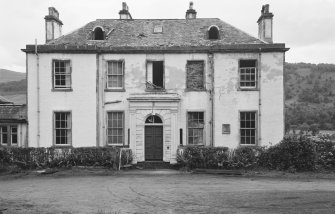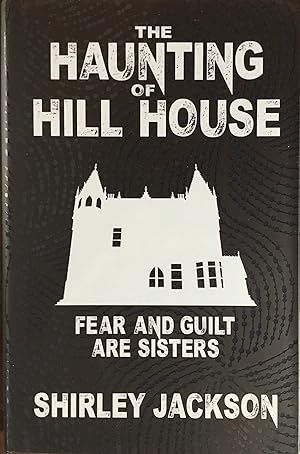The author’s biography in the front of the book describes Shirley Jackson’s writing style as “…characterized by her use of realistic settings for tales that often involve elements of horror and the occult”. I am familiar with the horror/ ghost story genre after watching scary movies practically every weekend with my three sisters. From my experience, horror movies are always less scary when my sisters are with me. The Haunting of Hill House follows familiar patterns from the horror and mystery genres. The story starts with strangers receiving letters to meet at a house and investigate whether it is supposedly haunted. The letters being sent to strangers with no previous acquaintance reminded me of the Agatha Christie novel, And Then There Were None or the plot of Clue. The warnings from the nearby town to stay away and the investigation of strange phenomena permeating from a house reminded me of H.P. Lovecraft’s short story “The Lurking Fear”. However, Jackson is not one to follow any genre to a “T”. Instead of the one-dimensional paranormal investigator, Dr. Montague, being the main protagonist as might be expected, the majority of the story is told from a third-person omniscient perspective focusing on the character Eleanor Vance. Eleanor at first appearance is a lonely mousy young woman, but as the story progresses Eleanor’s thoughts are quite complex, imaginative, and sometimes “not sane”. Eleanor’s unique perspective takes this story from just another ghost story to a psychological ghost story.
To begin, the story may be a haunted house story, but it lacks the “pop-out scares” of many other works from the genre. Jackson makes her readers shiver through tiny and perpetually unnerving descriptions of the Hill House.
Hill House, not sane, stood by itself against its hills, holding darkness within; it had stood so for eighty years and might stand for eighty more.
(Jackson 1)
There is so much to unpack in this characterization. I use the word characterization because Hill House is a character; it is not sane, it permeates darkness, and it just might outlive us all.

… the face of Hill House seemed awake, with a watchfulness from the blank windows and touch of glee in the eyebrow of a cornice.
(Jackson 24)
The descriptions of Hill House are endlessly unsettling. Eleanor’s first reaction to the house was that it was “vile” and “deceased” ; these are rather strange descriptions for a house (Jackson 23). Theodora repeatedly calls the house “filthy”, which is surprising given the fact that the house has been kept impeccably clean aside from a little dust and a stuffy atmosphere. The doctor calls the house “evil’ (Jackson 60). The descriptions “alive”, “dark”, “filthy” and “evil” are just a few of the repeated phrases used regarding Hill house. Chapter six of Kaja Silverman’s book The Subject of Semiotics, discussed five codes used in narrative. The repetition of words, phrases or ideas to represent something larger than itself is an example of the semic code. The semic code is my favorite to look for because it requires me to read every work the author writes and compare similar word choices throughout the book. To me, the description of Hill House reminds me of a leper, it is a living being that is infected by a sickness. If you dare to approach Hill House, be prepared to suffer the consequences. What makes the novel so unsettling, is the direct juxtaposition of the dark foreboding house and the lively companionship of the occupants. Four strangers brought together to investigate the house become a family of sorts. Dr. John Montague is a supernatural investigator looking for prestige. Theodora is a beautiful charismatic young woman with some telepathic abilities. Luke Sanderson is a certified rake who will likely inherit Hill House. Eleanor is a mousy woman who has spent her youth nursing a controlling mother and is now seeking an adventure and a place to call home. These four complete strangers take an instant liking to one another and immediately find ways to spend cozy evenings together despite their stranger circumstances.
My groupmate Venesa proposed the controlling idea of The Haunting Hill House as “Companionship can help get you through tough situations and the counter idea as “Being alone can lead to fear and helplessness”. Eleanor’s companionship did not save her in the end. Her friends abandoned her in her most vulnerable moments. They knew she was being affected by the house, but they kept her there for their own selfish reasons. The doctor wanted to finish his research. Theodora wanted a plaything to adore her and to abuse when the mood hit. When they finally decided to send her away, they pushed her out into the world without any support. In the network of controlling values, a possible opposing value, “Companionship leads to quarreling and peer-pressure” and “Being alone leads to the fulfillment of one’s dreams”.
Since I often watch scary movies with my sisters, it is not surprising that I picked up on a repetition of relationships between sisters throughout the novel. I originally thought that it was insignificant, but I chose to explore it anyway. The audience is introduced to Eleanor’s older sister, Carrie, during a quarrel between the sisters about the use of their car. Eleanor claims that she deserves the right to use the car she helped pay for on her trip to Hill House, but Carrie selfishly cares more about keeping the car than her younger sister’s well being. One of the first things said about Eleanor was that “The only other person she genuinely hated, now that her mother was dead, was her sister” (Jackson 3). This is not the only sisterly confrontation in the book. While learning the history of Hill House, it was revealed that the original owner of the house had two daughters. The daughters battled over the custody of Hill House after their father’s death. The spinster eldest sister left the house to the young woman who acted as her companion, rather than bequeath it to her sister. The younger sister endlessly harassed the companion until the young woman killed herself. My group leader recommended that I look for instances in the book that made me think of sisters without the author overtly saying it. Eleanor and Theodora become fast friends within their first few days at Hill House. Their fond sisterly relationship is not an exception to the precedent set by the other sister pair in the book. Their quarrel starts after Hill House starts singling Eleanor out. All Eleanor wants is to belong to a family and belong to a home. The house takes advantage of Eleanor’s weakness by separating her from the crowd and making her feel like she belongs only to Hill House. Dr. Montegue worries that Eleanor’s longing for acceptance will cause her to “welcome the perils of Hill House with a kind of sisterly embrace” (103). On page 107, the phrase “HELP ELEANOR COME HOME” appeared in chalk on the wall. Immediately, Eleanor is disturbed that she is being targeted by the house. Theodora suddenly accuses Eleanor of writing it herself for attention. Eleanor becomes incensed and snaps out of her stupor. The group believes that Theodora was just trying to distract Eleanor from being afraid. However, Eleanor doesn’t believe that to be the true motivation, and their relationship never fully recovers. Theo and Nell, like true sisters, constantly alternate between love and hate. They confide in each other in one minute and spit bitter words to each other in the next minute. As the book says, “Fear and guilt are sisters…” (127). Nell and Theo are jealous of each other and have an underlying battle for the group’s attention and Luke’s attention. The sisterly references throughout the book were full of jealousy, spite, malice, and fighting over possession. Nell’s relationship with Theo is one of the closest she had in her life, but even it was fraught with strive. Even Hill House and Eleanor wage a battle of sorts over possession of Eleanor herself. Eleanor wants to belong to people and a home, but relationships are complicated. Giving yourself to another comes at a cost. Jackson references the French Folk story Bluebeard, while Elenor is exploring Hill House on page 27. In the story for Bluebeard, a young woman marries a wealthy man who has killed seven of his previous wifes and locked their bodies in a basement room. The woman’s curiosity gets the best of her and she looks in the room. Bluebeard is furious and it takes the woman’s sister, Anne, and their brother to save her from the wrath of her husband. Within The Haunting of Hill House there is an example of filial love that saved the day and brought about happiness. There is the idea that once you find your forever home and your tribe of people, your life will be great. Eleanor found a group of people to appreciate her, but even they weren’t able to save her.

In the last act’s climax, Nelly seems to be under the influence of the house and the group urges her to leave. Nelly does not want to leave her friends, the house that calls to her, and the person she has blossomed into under its roof. Her friends are sending her away for her own safety and want her to distance herself from the house and forget the whole experience. Nelly believes that they want her to leave so that can continue to have fun without her.
They can’t turn me out or shut me out or laugh at me or hide from me; I won’t go, and Hill House belongs to me.
(Jackson 181)
In a desperate attempt to avoid the depressing life she would be returning to and to bind herself forever to the house, she put the pedal to the metal and aimed her car towards a tree in the driveway.

In the unending, crashing seconds before the car hurled into the tree she thought clearly, Why am I doing this? Why am I doing this? Why don’t they stop me?
(Jackson 182)
These last thoughts of clarity before her demise make the whole situation sadder. She didn’t die believing she belonged; she died believing her only friends let her down.
Rachel, I like how you described Eleanor’s thoughts as “not sane.” Just as you described her thoughts as not sane, Hill House is described as not sane on the very first page. There is no doubt that there is a connection between Eleanor and Hill House. Although she found companions such as Theodora and Luke, I feel like her real companion was Hill House. When she was forced to leave Hill House, she decided she could no longer live, no longer go on. Hill House had totally caught her and consumed her. As you mentioned, Eleanor says that Hill House belongs to her. Who would Eleanor be without it?
LikeLike